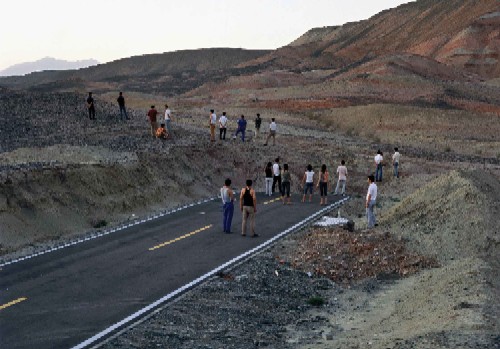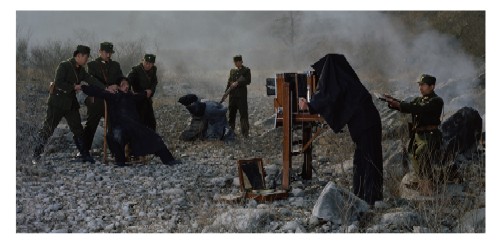Reviews & Articles
"See Through”
Hilary BINKS
at 12:14pm on 1st August 2008



In the past six months, there has been a noticeable shift in the traditional Hollywood Road/Wyndham Street art area of Hong Kong. As the bars and restaurants of Lan Kwai Fong increasingly encroach on the eastern end, art galleries are being pushed further west. Newly opened are two local galleries, The Cat Street Gallery at 222 Hollywood Road and Contemporary by Angela Li at 90-92 Hollywood Road; while two overseas galleries have shown their confidence in Hong Kong by establishing spaces here. These are Sundaram Tagore Gallery from New York and Beverly Hills at 57-59 Hollywood Road; and Tang Contemporary Art in the Hollywood Centre, 233 Hollywood Road (the same building as the Asia Art Archive).
Tang Contemporary Art Centre was established in the 798 art district of Beijing in 2006, with the aim of promoting and developing Chinese and foreign contemporary art. It purports to function not only as an art gallery but as an institution specializing in curating art exhibitions, publishing works on art theory and launching academic forums. The centre also has a gallery in Bangkok.
The gallery shows major artists including Zhang Xiaogang, Fang Lijun, Yue Minjun, Zheng Fanzhi, Wang Guangyi, Liu Wei and Liu Xiaodong; as well as mid-career artists like Guo Jin, Guo Wei, Wen Peijun and Yan Lei. However, it is also active in seeking out and promoting new generation artists working in all media from painting, sculpture, photography, installation to new media and conceptual art.
“See Through”, which runs from 17 June to 11 July, 2008, is a good example. Curated by Dr Wang Chunchen, Art Critic and Curator at the Central Academy of Fine Arts Museum in Beijing, the exhibition comprises the work of six young Chinese artists. The starting point of the exhibition was the idea that much contemporary Chinese art has become predictable and over-familiar; also that it relies too much on theoretical explanation and not enough on visual appreciation. In an effort to “See Through” this obfuscation, each artist has consciously conducted his or her own distinctive exploration towards a personal artistic language.
Many of the artists use day-to-day subjects to raise questions about different forms of artistic language and perception. Instead of painting images on canvas or paper in the traditional way, Chen Weiqun (b. 1975) first applies gouache paint to assemblages of fruits, vegetables and other objects, creating the effect of solid sculptures. Then he photographs them. The effect is to create a visual illusion, raising doubt or confusion about the relationship between painting and natural objects. Are we looking at a painting, or painted real objects? Chen says, “Actually, they are not [paintings], but on the level of visual cognition, they look like paintings. As I continue to do this, I come to realize that we unconsciously correct our original visual experience…” The works also have an installation element, as real fruits and vegetables, cooking pots, and plaster casts of classical heads with shards of pottery respectively were strewn on the floor in front of each photograph. In the case of the fruits and vegetables, this introduced a contrast between the transitory nature of the real objects and the permanence of the “painting” or photograph.
In Cai Weidong’s (b. 1978) series of black and white photographs, “Landscapes and Substances”, there is a sense of dislocation: the nude figures (including the artist) often view themselves in mirrors, as if needing proof of their very existence. Cai is also fascinated by history and stages historical events in his most recent works. “Eighth Day of the Twelfth Lunar Month” depicts the filming of the dramatic arrest of a rebel by Kuomintang guards. The title derives from the day on which the photograph was shot. Is this a true episode or a fictional one? How can we create an accurate visual method of viewing the past? In “Image Feast”, a modern Adam and Eve stroll beneath the Tree of Knowledge, laden with images of famous artworks. Will they give in to temptation and embrace these, or transform them into a new visual intelligence? “Genesis 1.3” in which the camera gradually zooms in on the text “And God said, Let there be light: and there was light” suggests that they should rely on their own inspiration.
Guan Shi (b. 1974) is a pioneering conceptual photographer who in 1999 started to take one photo every day. In his “Diary”, he recorded the mundane, repetitive actions that make up ordinary life. In his “37° N” series, completed in 2003-4, Guan Shi used documentary photography to record 210 days in his life. Using a GPS receiver, he photographed himself at each longitudinal intersection along the 37° N latitude in China. His main aim was to deviate from normal daily life and carry out a scientific experiment which also had a ritual aspect. In his “Road” series (2007) seen in this exhibition, he shifts again to a recording of artificially constructed reality. A section of tarmac road complete with white markings ends abruptly in the middle of a remote mountainous Xinjiang landscape. A group of people stare into the distance ahead, whether in hope or despair, it is not clear. Guan Shi built the road himself for this project. The effect is surreal and unsettling.
At the centre of the exhibition, Yu Bogong’s (b. 1975) installation “Speakers of Herbal Medicine” attempted to create a multi-sensory experience. Giant-size wooden sculptures of seeds and fruits used in Chinese medicine were positioned on stands of different heights in a circle, each fitted with a speaker emitting the natural sounds of birds and insects in the forest. The artist believes that from the womb, we are comforted by the intimacy of sound. Our adult souls are in need of healing by both visual and aural stimuli, and only by turning to the world of Nature can we find these. Although the integration of the speakers in the sculptures seemed forced, the work was strangely mesmerizing. Another installation, “Movie Theater”, was harder to interpret. The miniature wooden model of a theatre had a screen at one end with the words “The Dream is Over”, perhaps alluding to the seductive role played by this art form in society and the contrast with reality.
Photographer, performance artist and painter, Chen Guang (b. 1971) is inspired by his own sexual consciousness. From 2002 he created the “My Emotions and Sex” series of photographs which aims to show the relationship between the individual and different elements in society. In “The Great Wall” series (2004), he explored the sexual experience more intensively using the Great Wall, a cultural and military symbol of China, as the backdrop. Chen Guang’s erotic “Races” video (2006) shows his relationship with an octogenarian man. One photograph originating from this video was shown in the exhibition. Also on display was “Ruby”, a painting in oil on canvas which had all the immediacy of a photograph. A poster featuring this painting, intended to advertise the exhibition, was censored by the landlord.
Liu Lining’s (b. 1980) surrealist works in acrylic on canvas convey a sense of unease and threat to the individual in modern society. Many of his works are inspired by childhood memories and are imbued with melancholy and loneliness. “Childhood” shows the artist as a boy alone in a field beneath bare winter trees and an eerie moon, trailing a doll by a leash. On closer inspection, the doll turns out to be one of Velázquez’s “Las Meninas”. In the background is the railway that ran close to his home as a boy. More sinister still, “Hidden Danger” shows two politicians or leaders debating but apparently not engaging, with obviously dire repercussions on society. Armed gangsters lurk in the undergrowth, people and animals alike try in vain to hide. Life is uncertain and insecure.
The six artists shown each display a distinct artistic voice and perspective. In contrast with the many commercial exhibitions in Hong Kong, it is refreshing to find a willingness to explore unusual avenues when selecting artists and subject approaches, and to see a thoughtfully curated exhibition.
Exhibition : See Through
Date : 17.6 – 11.7.2008
Venue : Tang Contemporary Art
Address : Basement, Hollywood Centre, 223 Hollywood Road, Sheung Wan, Hong Kong
Tel : 852 2544 9918
Artists : Bogong YU(于伯公 b.1970), Shi GUAN(關矢 b.1974), Weidong CAI(蔡衛東 b.1978), Weiqun CHEN(陳衛群 b.1975), Lining LIU, Guang CHEN(陳光 b.1971)
Curator : Chunchen WANG(王春辰)
|
|
|
|
|
|
